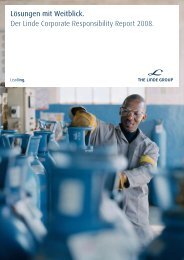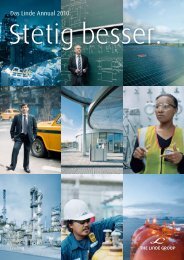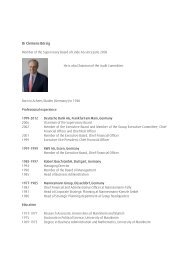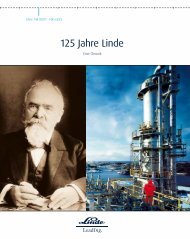The complete history of the development of The - The Linde Group
The complete history of the development of The - The Linde Group
The complete history of the development of The - The Linde Group
Create successful ePaper yourself
Turn your PDF publications into a flip-book with our unique Google optimized e-Paper software.
42<br />
N o 0875 Process for <strong>the</strong> melting<br />
<strong>of</strong> metals onto electrically conductive bodies,<br />
in particular for electric welding.<br />
Cold storage facilities and ice production<br />
<strong>The</strong> cold storage houses built by <strong>the</strong> “Gesellschaft für <strong>Linde</strong>’s<br />
Eismaschinen” also went through a boom period as a result <strong>of</strong><br />
<strong>the</strong> National Socialists’ self-sufficiency policies. While <strong>the</strong> company<br />
posted a loss in this division in 1933, <strong>the</strong> economic situation<br />
for refrigerated buildings and ice factories was much improved in<br />
1934. Of “considerable influence” here were <strong>the</strong> “measures by<br />
<strong>the</strong> Reich to support <strong>the</strong> products <strong>of</strong> <strong>the</strong> national economy and<br />
to regulate <strong>the</strong> market in <strong>the</strong>se products,” wrote <strong>the</strong> Executive<br />
Board in <strong>the</strong> annual report from 1934.<br />
Deep-freeze food storage meant a new field <strong>of</strong> business for<br />
<strong>the</strong> refrigeration sector. Pr<strong>of</strong>. Rudolf Plank, Germany’s greatest<br />
refrigeration engineer after Carl von <strong>Linde</strong>, thus founded <strong>the</strong><br />
Reichsinstitut für Lebensmittelfrischhaltung in Karlsruhe, and <strong>the</strong><br />
“Institut für Lebensmittelforschung” was established in Munich.<br />
<strong>Linde</strong> supplied <strong>the</strong> testing equipment for both institutes.<br />
Numerous quick-freeze devices soon followed for long-term<br />
food supply storage.<br />
Due to <strong>the</strong> strong demand for refrigerated storage, <strong>Linde</strong><br />
even built a few new refrigerated storage buildings after a long<br />
interval, starting in <strong>the</strong> mid-1930s: One project which <strong>Linde</strong> had<br />
been planning for several years was opened in 1935, while a<br />
second facility was built in 1937 in cooperation with <strong>the</strong> city <strong>of</strong><br />
Magdeburg.<br />
Skating rink business<br />
And yet ano<strong>the</strong>r application <strong>of</strong> ice technology flourished in <strong>the</strong><br />
mid-1930s: ice skating rinks. Carl von <strong>Linde</strong> had had his eye on<br />
this market since <strong>the</strong> company’s early days and in 1882 presented<br />
<strong>the</strong> world’s first manmade ice rink at <strong>the</strong> German Patent<br />
and Utility Model Exhibition in Frankfurt am Main. Ano<strong>the</strong>r ice<br />
rink followed shortly after in Nuremberg. But <strong>the</strong> breakthrough<br />
was still some time away.<br />
1938 1939<br />
Konrad Zuse creates <strong>the</strong> first computer<br />
with his Z1 calculating machine.<br />
World War II begins.<br />
N o 0895 Process for<br />
<strong>the</strong> evaporation <strong>of</strong> liquid oxygen.<br />
In anticipation <strong>of</strong> <strong>the</strong> upcoming 1936 Olympic Games in<br />
Berlin, and promoted by state propaganda, Germany was enjoying<br />
a widespread interest in sports, which prompted <strong>Linde</strong> to<br />
build <strong>the</strong> <strong>Linde</strong> Stadium in Nuremberg in 1935. This <strong>Linde</strong> operated<br />
sports center, with an outdoor ice skating rink and swimming<br />
pool, served as advertising for <strong>Linde</strong> – and with much<br />
success: By <strong>the</strong> end <strong>of</strong> 1936 <strong>Linde</strong> had already received orders<br />
for ice skating rinks in Hamburg, Munich, Krefeld, Dortmund<br />
and Cologne. Of <strong>the</strong> twelve ice skating rinks erected in Germany<br />
in <strong>the</strong> 1930s – ten outdoor and two indoor rinks – seven were<br />
built by <strong>Linde</strong>.<br />
After World War II, ice revues stimulated demand once<br />
again. First <strong>Linde</strong> built a small ice rink for variety shows for<br />
American soldiers, to be followed soon after by transportable<br />
skating rinks – such as one in 1950 for <strong>the</strong> famous German<br />
skating pair Maxi and Ernst Baier.<br />
Güldner Motoren-Gesellschaft mbH<br />
<strong>The</strong> economic situation at <strong>the</strong> Aschaffenburg plant, which made<br />
various sizes and types <strong>of</strong> diesel engines, as well as compressor<br />
parts for refrigeration machines, remained precarious despite<br />
increasing sales figures and quantities. Sales <strong>of</strong> large engines in<br />
particular fell sharply in <strong>the</strong> early 1930s.<br />
In response, Güldner added small diesel engines to its production<br />
line and in 1935 built an additional factory building to<br />
meet <strong>the</strong> increasing demand. This product line, with engine<br />
outputs <strong>of</strong> between 20 and 120 hp, was met with strong interest,<br />
particularly in agricultural machinery. In 1938 Güldner began<br />
building tractors itself. In <strong>the</strong> 1950s this line <strong>of</strong> business became<br />
<strong>the</strong> Güldner group’s strongest sales performer.<br />
Photo right: Tractor production at Güldner Motoren-Gesellschaft mbH



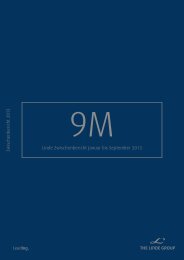
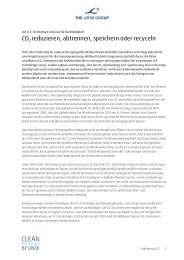

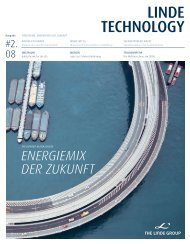

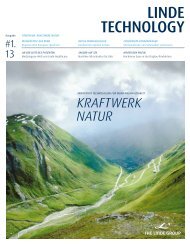

![[41] Anteilsbesitzliste des Linde Konzerns und ... - The Linde Group](https://img.yumpu.com/8356102/1/184x260/41-anteilsbesitzliste-des-linde-konzerns-und-the-linde-group.jpg?quality=85)
![[41] Anteilsbesitzliste des Linde Konzerns und ... - The Linde Group](https://img.yumpu.com/8356076/1/184x260/41-anteilsbesitzliste-des-linde-konzerns-und-the-linde-group.jpg?quality=85)
